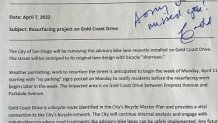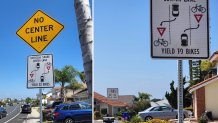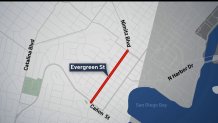A week after the city of San Diego implemented a confusing single-lane roadway in Mira Mesa in order to add bike lanes, Mayor Todd Gloria's office informed residents that workers will return the street striping to its original design.
"The city of San Diego will be removing the advisory bike lane recently installed on Gold Coast Drive," said the mayor in a letter distributed Friday to residents. "The street will be restriped to its original lane design with bicycle 'sharrows.' "

A "sharrow" is defined as a "sign showing a bicycle under two wide arrows that is painted on a road to show that people riding bicycles and those driving cars must share the road."
Get top local stories in San Diego delivered to you every morning. Sign up for NBC San Diego's News Headlines newsletter.
The residents were informed that, weather permitting, the work would take place next week.
Furthermore, the mayor, who visited the neighborhood on Friday, said that plans to implement the ABL design in Point Loma were "on hold," as were plans for implementing the ABLs in other communities in San Diego.

"Because [the design] is unique, the first ever in our city ... we owed it to the community to spend time with them, to explain what was going to happen, how this works, and we did not do that," Gloria said. "That failure is something I regret and something we're gonna fix."
Local
While it's possible that other communities will have ABLs in the future, Gloria said, community outreach efforts will take place ahead of time to ensure drivers, residents and bicyclists know how to utilize them and aren't caught off-guard.
"I think it's unlikely to be on this particular street, but it will appear in other parts of the city," Gloria said. "The difference will be is that we will inform the community in advance, we'll work with them hand-in-hand to make sure this is the appropriate treatment for that particular stretch of land."
Point Loma ABLs
Residents of the proposed street in Point Loma told NBC earlier this week that they no idea they were days away from living on a so-called advisory bike lane prior to the city putting plans for the street redesign on hold.
Plans for future ABLs were paused after Mira Mesa neighbors complained about it in their neighborhood, claiming — and the city later admitting — it was installed without a sufficient community outreach campaign.
Residents of Evergreen Street in Point Loma sounded off after nearly suffering the same fate.
"Nobody informed us," Evergreen Street resident Lydia Reuland said. "I didn’t get a flyer in the mail. Nothing."
Like neighbors on Gold Coast Drive in Mira Mesa, many living on Evergreen Street say the ABL design is confusing and doesn’t work on their street. The redesign project was put on hold while the city comes up with a community outreach plan, but frustration over the city’s process hasn't stopped.
"I really think it is going to aggravate everything in the immediate area for the residents," neighbor Richard Jackson said.
The ABL is a new take on how residential street traffic should flow. Intended to make streets more cyclist-friendly, ABLs offer a single lane for bi-directional traffic to share in the center of two bike lanes. If oncoming cars are approaching, vehicles are supposed to veer into the bike lanes and pass.
These road signs posted along Gold Coast Drive help explain the rules of the road to drivers.
Evergreen Street was resurfaced and chalked in the ABL pattern between Nimitz Boulevard and Cañon Road two weeks ago, according to neighbors, right around the same time the city painted the new design on Gold Coast Drive.
The Mira Mesa Town Council hosted a virtual forum with members of the city’s Transportation Department on Monday after frustration from residents boiled over. The city admitted it didn’t do enough to inform Gold Coast residents about the changes and said it was pausing other ABL plans in city limits.
Reuland thinks the ABL plan on Evergreen should be scrapped completely.
"It is very narrow," she said about her street. "There is not enough space for two cars to get by."
Reuland and Jackson share a friendship and a long history there. Jackson says Evergreen is a throughway for morning commuters who speed if traffic isn’t already jammed up.
“In the early a.m. when you got the flow of traffic heading that way, and you have the cars going against in the opposite direction, that’s going to be a little thorny,” Jackson said.
The idea that two-way traffic and cyclists will kindly yield to one another on this narrow lane seems remote to Jackson. He, like Reuland, is also concerned Evergreen isn’t wide enough to begin with.

He pays the city a fee so he can park his boat in front of his house temporarily for hours at a time, several times a year. But he says his trailer, and others along the street, encroach the bike path. There is a dual-wheeled truck parked on the street less than a block away.
"The amount of cyclists that are using this for that purpose are minimal, extremely minimal, to the amount of cars that are coming through," Jackson said.
The line of neighbors in favor of an ABL on Evergreen Street starts with Nicole Burges. She also plans on assisting the city with neighborhood outreach.
"I’m helping our community members understand this is a wonderful way to calm traffic through our neighborhoods," she said.
ABLs are approved by the city’s Mobility Board, made up of representatives from every city council district plus four “at-large” representatives. All are appointed by the mayor and confirmed by the city council. The board held a meeting Wednesday but didn’t answer any questions regarding ABLs.



